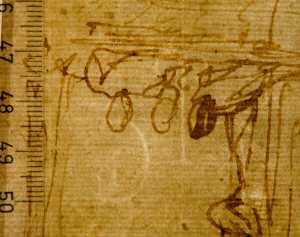Specifications
| Title | Composition Study for 'The Baptism of Josias by St James the Greater' |
|---|---|
| Material and technique | Black chalk, pen and brown ink |
| Object type |
Drawing
> Two-dimensional object
> Art object
|
| Location | This object is in storage |
| Dimensions |
Height 291 mm Width 211 mm |
|---|---|
| Artists |
Draughtsman:
Alessandro Maganza
Previously attributed: El Greco |
| Accession number | S 25 (PK) |
| Credits | Loan Stichting Museum Boijmans Van Beuningen (former Koenigs collection), 1940 |
| Department | Drawings & Prints |
| Acquisition date | 1940 |
| Creation date | in circa 1600-1610 |
| Watermark | Countermark Letters FG surmounted by a trefoil (35 x 30 mm, at top right, on P7 of 8P, vH), probably belonging to a Crossbow type watermark. An almost identical countermark is found in another drawing by Maganza in MBVB, inv. S 22. [see image] |
| Inscriptions | 's. Giac[om]o. Maggior e Giosia C4 98' (bottom, pen and brown ink) |
| Collector | Collector / Franz Koenigs |
| Mark | F.W. Koenigs (L.1023a on missing removed mount?) |
| Provenance | Sir Archibald Alison (1792-1867), Glasgow (in an album); art dealer Luigi Grassi (1858-1937, L.1171b), Florence (from the album, probably dismembered by him); Franz W. Koenigs (1881-1941, L.1023a), Haarlem, acquired in 1930 (attributed to El Greco); D.G. van Beuningen (1877-1955), Rotterdam, acquired with the Koenigs Collection in 1940 and donated to Stichting Museum Boijmans Van Beuningen |
| Exhibitions | Paris 1935, no. 715 |
| Internal exhibitions |
Van Eyck tot Bruegel (1994) |
| Research |
Show research Italian Drawings 1400-1600 |
| Literature | Paris 1935, no. 715 (J. Tintoretto school); Tietze/Tietze-Conrat 1944, pp. 27, 292 under no. A 1754 and A 1757 (mid 17th-c.); Wethey 1962, p. 153 (Venetian Mannerist); Byam Shaw 1967, p. 48, fig. 9 (attr. Maganza); Byam Shaw 1976, under no. 840; Byam Shaw 1983, under no. 252; Meijer 1984a, p. 476, fig. 13; Forlani Tempesti 1991, pp. 329-330; Paris 1996, under no. 61; Rearick 2001, p. 235 (erroneously referring to inv. S 28); Matarrese 2002, pp. 56-57, 73; Boschini/De Boer 2008, pp. 387-388, fig. 357; Meijer 2017, pp. 257-258, fig. 5 |
| Material | |
| Object | |
| Geographical origin | Italy > Southern Europe > Europe |
| Place of manufacture | Vicenza > Veneto region > Italy > Southern Europe > Europe |
Do you have corrections or additional information about this work? Please, send us a message
























